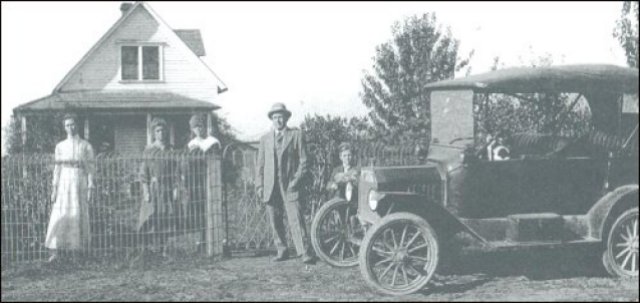
My friends Kathleen Jardine and Jim Cameron are the most practiced long-term gardeners I know. Kathleen was the first organic gardener I ever met, back when we were students in Oklahoma, and then again when we shared a collective household in Charlotte. Now she and Jim are designers and builders of passive-solar homes
(SunGarden Houses) in Chapel Hill, NC. Around their own beautiful home in Chapel Hill, they have one of the most luscious gardens I've ever seen. After we visited them a couple of months ago, my son said, "I'd give anything to live in a place like that," and he meant it. I told him I felt the same way.
But we don't. We live in a squat and homely little house in Charlotte, on a very ordinary little suburban street. We used to have some woods out back, but developers turned it into a subdivision. I'm worried that we might lose some of the big oaks on our street because of our long drought combined with the horrible city-wide cankerworm infestation. The trees are the street's primary asset, and there aren't that many to begin with. If they go, I will be very sad. One massive tulip poplar has already fallen. It just cracked one day and fell over. There wasn't even any wind, although the main trunk had always been leaning, like the leaning Tower of Pisa. I was at the computer and heard a loud crack and then a crash, and then the power went out. I ran outside, and the huge tree had taken down 3 other trees on its way down. Plus, it blocked the street and knocked the utility pole down. The tree had been weakened I think by the drought and the dadgum worms.
In spite of development and drought and cankerworms, we do still have our little raised-bed garden in the side yard. Ken has already got the cool weather plants going, the lettuce and chard and spinach and onions. But it's about time to plant the warm-weather veggies - the tomatoes, okra, beans, peppers. April 15 is the customary date in the Piedmont of NC when another frost is considered unlikely.
Which leads to the subject of mulching. We've been in this drought situation for eight months or longer. Watering is allowed only once a week now. Mulching drastically reduces the amount of water loss from garden soil.
I called Kathleen this morning to ask her about mulching. She said she puts dead leaves around her plants, 3 to 5 inches deep. Any deeper and the water from above can't penetrate. The leaves don't have to be chopped up leaves, but chopped up is good. Then on top of the 3 to 5 inches of leaves, she puts shredded hardwood mulch. She said the hardwood mulch will not wash or float away, so it anchors the leaves. She arranged with the municipal government of a small town near her to deliver the hardwood mulch to their home. The town makes mulch from collected yard waste.
We have plenty of leaves, and that's generally all we use. For our flat and relatively sheltered garden, anchoring is not really necessary. We can, though, get free mulch from Charlotte's recycling center on Hickory Grove Road. It's made of shredded yard waste, much of it shredded wood. Might have some grass seed in it. But still...using it recycles the stuff, keeps it out of the landfill, plus it's free.
I'm leery of
buying shredded hardwood mulch, given the deforestation that's going on in the Southeast at the hands of the timber industry. I know that some trees are cut expressly for the purpose of creating mulch to sell in retail outlets; for example, cypress trees in a swath across southern Louisiana.
I'm definitely not buying any dyed mulch, regardless of the source. I learned the hard way about mulch dyed red, after our neighbors laid out a ton of red mulch right next to our organic vegetable garden.
I hate confrontation....but I had to do it. Read the story.Key words: red mulch cankerworms drought April 15 vegetable garden hardwood mulch leaf mulch development gardening Sungarden Houses Kathleen Jardine Jim Cameron cypress mulch
 Abstinence-only is big in Texas.
Abstinence-only is big in Texas.











